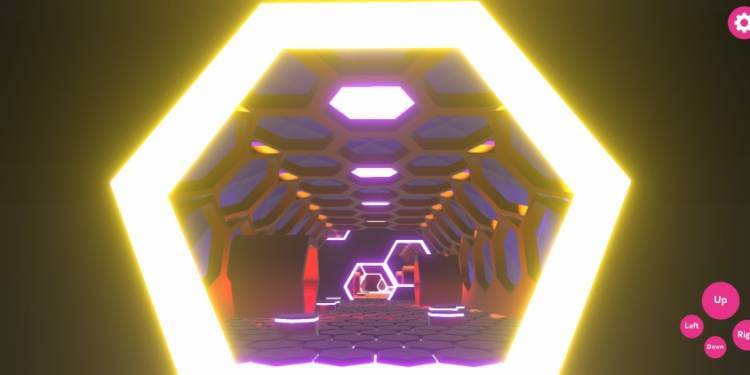Student creates fully immersive game to showcase work

Article by: Gaynor Orvis
Publication date:Bradley O'Neill is a BA (Hons) Games Development student heading into his third year. He has come up with an ingenious way to showcase student work and has big ideas to improve the accessibility of art by taking exhibitions online. We caught up with Bradley to find out more.
How did the idea for the game come about?
So it's actually been in the works for ages now. It started in November last year when I was hoping to help create a game with the fashion department. Unfortunately, the fashion project never took off, but anyway we had this really cool idea and the foundations for it, so we thought, “why not keep working on it?”
So we continued working on it all winter last year, but then our momentum kind of died down because of lockdown and because we weren’t able to meet up and talk about our progress properly. But then the Ravensbourne Unit came along in our second year, and Emelie, Ravensbourne's Mindsets and Skillsets Coordinator, was looking for a way to show off all the student’s work.
What is the Ravensbourne unit?
So the Ravensbourne Unit is a compulsory unit for all second-year students. The unit is all about students taking personal responsibility for their own learning and also for their own role in society. It's a self-initiated project that can be presented any way the students want, from a series of images to a short video.
Emelie was keen to find a way to display student's work in a new and engaging way and to not just have it sit on a static website.. So I thought "Okay, we’ve got this great idea just sitting here. We can take the principles of our game and make it work for this project." So anyway, I pitched the idea to Emelie, and she loved the idea straight away and it kind of just evolved from there.
Can you describe in simple terms how the game is built?
The best way I can describe it is like building blocks, so it is all modular. So you’ve got all the features you want and from there you can build it in any way you like. You can build corridors, you can build a big open space if you like. The software is really easy to pick up – we’ve really tried to make it as accessible as possible. It's pretty intuitive, and you can start making stuff with it straight away.
The game actually has VR potential too and is called ‘Tide’ after the Tide on the peninsula. It can stream straight from Ravensbourne’s Vimeo account and the game runs straight from a browser on PCs and Mac and eventually on mobile, too.
The game’s homepage is completely on brand and looks just like the main Ravensbourne website. The foyer area of the game is also a pretty accurate replica of Level 4 of the Ravensbourne building, with our circular windows and purple sofas.
You can navigate with your keyboard or on screen and has been designed with accessibility in mind. The hexagon corridor in the game was also modelled on a Kaleidoscope and each student showcasing work has their own individual room. It is also possible to add in all the students’ names and courses at the door.
How long did it take you to create the game?
We started it in April, so roughly it took around five or six months to finish. It was actually a ridiculously quick turnaround in terms of games development. I could build the game as part of my coursework, so that is why I was able to get it done so quickly.
Did your course leader help with this project?
Yes, so my course leader Dev Byeajee was such a big support. He was always there to talk to about the project. I come from a more technical background when it comes to games development, whereas Dev is more creative and focused on the art, so he was the missing link, so to speak.
Personally, I just like building things and making things work. So we had this amazing prototype built, but we didn’t really know what sort of environment to actually put all the components in. So throughout the summer I had loads of conversations with Dev and he did some sketches and put together some concepts for how everything would look and feel – that made things move so much faster. He was a big lover of the project and really believed in it from day one.
Do you think the experience of creating the game will help prepare you for the future?
I learned so much from the project. It was my first professional project and first piece of work that I was working on individually. It actually came at a very important time for me because I’m now going straight into my final major project. This will be very similar in terms of project managing my own piece of work. I’m going to make another game for this project, so a lot of the skills I’ve developed here will be applicable when I’m working on my final major project.
It was also really beneficial to be able to make the mistakes now, before leaving university and moving into industry. I think it gave me a great taste of what I had to do to manage my own time, too. It is been so useful to be able to take everything I’ve learnt over the past two years and actually apply it all to a real-life project, all before I’ve actually left university too.
What do you hope to achieve with the game?
Hopefully it can be a good tool to entice prospective students. But more than that, we were really keen to do something that no other university had done before. We wanted to create something that is really unique and something outside of the box. We want to get universities turning their heads and saying' "wow, that's different".
Now the blueprints are in place, we can really just run with this idea. There is so much more that we can do with it. The whole reason I started the project is because I think it really fits into the spirit of the university. We really go the extra mile to create something totally different, and this project really is a testament to this.
Especially during the pandemic, when you can’t necessarily just go to an exhibition and it's just not as easy to go and see work in the physical, this is a way to experience it from wherever you are in the world. It opens up so many possibilities, like virtual museums and presenting work on a much bigger scale. It provides so many alternatives to a physical showcase.
Check out the game.
Explore more of Bradley's work:
Instagram: @bradley.makes.games
Linkedin: https://www.linkedin.com/in/bradley-o-neill-39922317b/
Website: www.bradleyoneill.com









